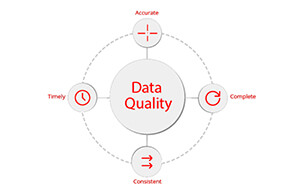Why efficient energy management starts with quality data

Tom Anderton, Product and Services Manager, TEAM Energy, explains why we put quality data at the heart of our digital energy management solutions, and so should you.
Utility costs are often the second or third largest cost for an organisation, and often the one under a lot of scrutiny from a budget cutting and sustainability point of view. Having the right tools to help you manage, control and reduce energy usage is paramount.
We can’t support our customers to build an optimised energy management service on a foundation of poor data quality. For us, data is at the heart of everything we do and is the beginning of efficient monitoring and targeting. Good quality data is crucial for your business. It is the key to compliance, streamlined budgeting, and surpassing carbon reduction targets. It also provides ultimate portfolio transparency in the mission to drive down consumption.
For energy professionals the “no news is good news” approach is not good business practice. Being able to “right a wrong” as soon as it’s happened is essential.
To facilitate the most accurate monitoring, targeting and reporting of energy and consumption, we believe that quality data needs to have the following attributes:
• Accuracy – data correctly reflects what is being measured and its expected behaviour
• Completeness – all expected data is present and without gaps
• Consistency – data conforms to a required format that agree with each other
• Timeliness – data is available to support fulfilment of energy management duties on time
Data that is not accurate, complete, consistent, and timely can lead to:
• False reporting
• Ill-conceived energy strategies and activities
• Unreliable forecasting, capacity management, and procurement strategy
• Flawed compliance submissions (SECR, GHG, for example)
• Disengaged stakeholders who no longer trust the reports and data they are seeing.
And even the smallest anomaly in data can cause a significant skew on the truth.
Advanced data quality
We are working hard to keep our energy management solution relevant to the needs of energy professionals from a range of sectors. The one thing all energy professionals have in common is data. Our new data monitoring suite promotes proactive energy management with robust and auditable data, supporting the four pillars of data quality. Reliability and completeness of information is assessed without having to review streams of data manually.
High quality data can be achieved through the data monitoring framework, addressing the following issues:
• Gaps – where there are gaps in the interval meter read data that has been received
• Unexpected data – where data has been received but was not expected (e.g. where a site has closed, or a meter has been disconnected)
• Overdue – where data is due based on how often it is expected to be loaded, but has not been received
• No data – completely missing data for all time
This functionality gives energy professionals a transparent and single version of the truth and it has capability to find and respond to the issues quickly. Users can define their own monitoring strategies within the framework. These can control whether or how the system searches for data gaps, overdue data and unexpected data in periodic channels.
Trend analysis
Our work to give further confidence in data comes in our next software upgrade which delivers a new trend analysis feature. This will automatically analyse incoming periodic interval data to identify suspect or erroneous readings, to check whether data is in line with what is expected.
There are two core functions that this supports:
• Dynamic profiling checks the most recent performance against a previous time period which
helps to identify step changes in trends: spikes and drops
• Fixed profiling measures the most recent performance against a fixed and defined profile,
helping to monitor against very specific thresholds (i.e. specific baseload monitoring or identifying potential water leaks by checking night-time periods)
Trend analysis builds on the data monitoring framework ensuring that data issues and notifications are raised in a consistent and standardised way. It prompts investigative action and is:
• Proactive – automating monitoring and alerting allows energy teams to be notified of suspect utility usage
• Time saving – removing the need to trawl through data or reports to identify potential issues
• Focused – prioritising fixing issues and saving energy rather than finding them in the first place
• Flexible and customisable – allowing users to adjust the checks to suit their needs
Data is a one of the most valuable resources an organisation owns, and Sigma puts data at the forefront of energy management strategies with crystal clear clarity.
We know how important data is, which is why we are continuing to enhance our solution with data monitoring features. Further releases will deliver advanced consumption trend analysis and exception reporting, and greater data transparency in estate management. These are all set out in our product roadmap.







